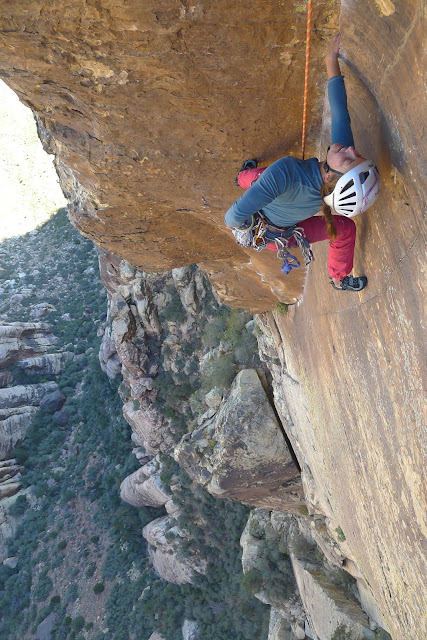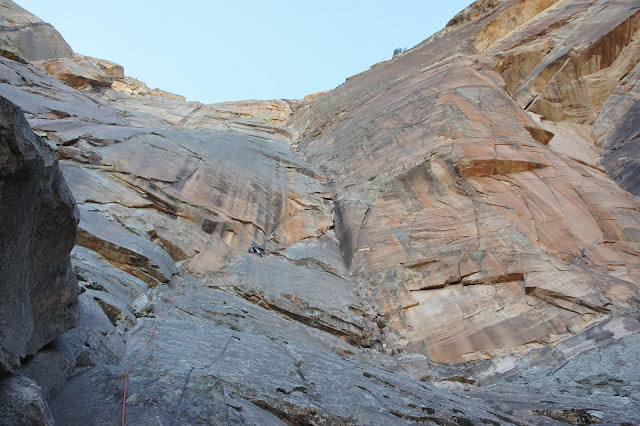If a climber was to have a bucket list, I think that close to the top of the list would be to do a road-trip in America. With autumnal alpine conditions looking less than average, this year seemed like a good time to head west in search of the American dream. Despite having been to Alaska a number of times, I felt like I'd never been to America itself. Burgers and pristine granite were calling.
After a summer of guiding in the Alps, fellow snowplodder, Fairhead specialist and Ireland's most handsome climber John Mccune and myself had hatched a vague plan to go and get shutdown by some wide cracks in Yosemite, followed by wherever the wind would take us. With a load of friends also floating around the US this autumn, it was sure to be a fun trip climbing or not.
 |
| John |
Upon arriving in "the valley", we set about our Yosemite apprenticeship. Cragging at Arch rock - my favourite small crag in the valley - and doing many medium-sized classics. Moratorium, The Rostrum, D.N.B (highly recommended, and no, it doesn't sand for Do Not Bother), Astroman, South face of Washington Column.
 |
| Moratorium |
 |
| El Cap - a site to behold. |
 |
| Some amusing toilet graffiti. |
 |
| Refining(/discovering) our aid skills. |
 |
| The world classic that is Astroman. |
 |
| John seconding the Harding slot. A bucket list pitch. |
 |
| The West face of El Cap. |
 |
| Myself on Crimson Cringe, a contender for the best granite pitch I've ever done. |
After a couple of weeks, much panting and screaming inside offwidths and a heavy schooling on many a 5.10, we felt like we were making a bit of progress; we'd sussed the shower situation, how to get in and out of the valley without paying and John had found an array of sections of foam matting he could sleep on. We figured we should get stuck in to something a bit meatier.
NIAD, or the Nose In A Day was high on our priorites. After a brief recce of the first section the day before, we launched at about 5 a.m. and about 18 hours later both sat next to the famous tree that marks the top of the route on the rim of El Cap. 34 pitches of involved climbing, each more famous than the last had made for a tiring day, especially as we dropped a jumar low down, and never quite got a good system sorted for the next 25 pitches.
 |
| Shortly after sunrise, 800 metres of compact granite above. |
 |
| The Great Roof. A defining pitch. |
After NIAD and the west face of El Cap, we decided to get involved with trying to free Freerider, a variation to the uber classic Salathe wall. We didn't finish the route, but went to pitch 25 (of about 32) freeing all the pitches apart from one between us, including the "Huber Pitch", the number crux at 12d/13a which John dispatched swiftly. However, we were under no illusion that this was the crux for us, the wide 5.11's being far more of a challenge.
The route turned in to more of a recce than going for it properly. On waking up at the niche, the corner system above was glazed in ice, and even sported a stalactite on the pitch above the spire. Not exactly what we were expecting, we spent day two huddled in the niche under a bombardment of falling ice. Also, the fact that we hadn't done the monster offwidth on day one (we arrived at its base in the dark, and went up the A1 pitch of Salathe instead) felt like a real copout, being a key, and one of the crux pitches of the route.
However, it was a great three days we spent on the wall, and now I know what it involves, i'm really inspired to go back and do it properly. Minimal hauling or even in a day, would be a fantastic way to climb freerider.
 |
| John struggling with the haul bags on the lower section of Freerider. |
 |
| Just above heart ledges, on day 1. |
 |
| John in the alcove. A luxurious bivi. |
 |
| John chilling on El Cap spire. |
 |
| Myself on the 11c offwidth above the spire. |
 |
| Stunning climbing |
 |
| Evening light on the Muir wall. |
 |
| John on the Huber pitch. |
We went from pitch 24 of freerider to the pizza house in about 5 hours, which really goes to show how well designed El Cap is for climbers. After a month in the valley we were definitely wanting out, so we went surfing.
 |
| A massive whale. |
 |
| Pacific surf in Santa Cruz. |
As per normal, I got scared and thought I was going to die, but it was a lot of fun.
 |
| A fun week was spent with my friend Michelle from Seattle. She taught me the ways of America and laughed at my bad driving. |
 |
| John on Cloud Tower. |
 |
| Heather on Cloud Tower. |
 |
| Heather styling. |
 |
| Myself on pitch 1 of Rainbow wall. |
 |
| Rainbow wall |
 |
| John on Monster Skank. An amazing 13b that just managed to evade us both. Next time. |
Although at first it seemed wrong to be sport climbing in America, we were lured in to a fantastic route in the last few days of our trip called "Monster Skank", our redpoints were ending higher and higher, but fate intervened. We had one last chance to get it on the last day, but John discovered the morning we left for the crag that his passport, harness, and rock shoes had been misplaced. Climbing Monster Skank was no longer a possibility, as we made a frantic drive to the British consulate in San Francisco in order to get an emergency passport before out flight back to the UK the next day.
A great 1st world adventure. I can see this being the first of many rock trips to the US. A country designed for road-tripping, crack climbing, and mass consumption of burgers and IPA.










































